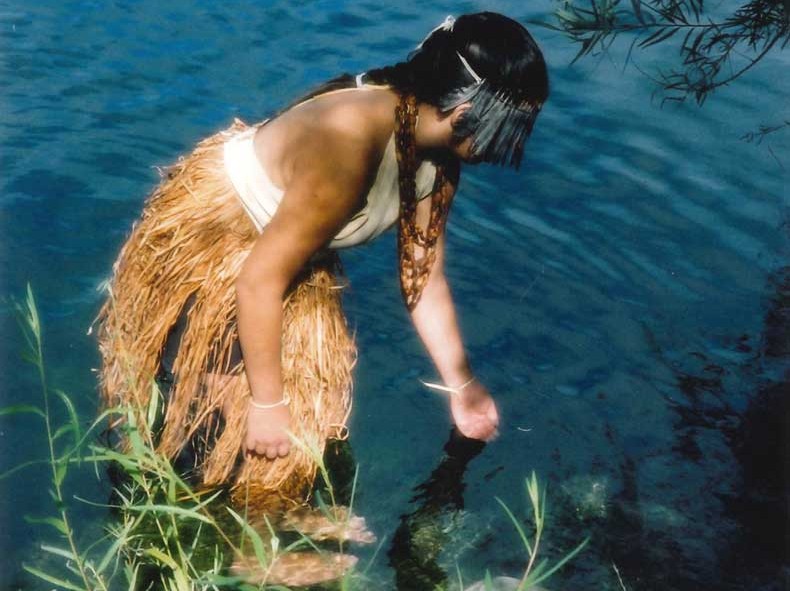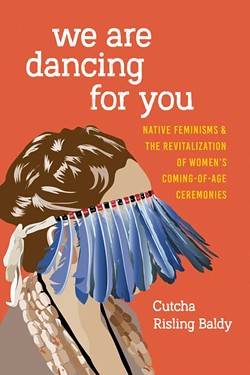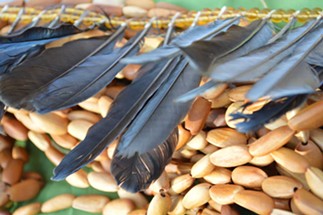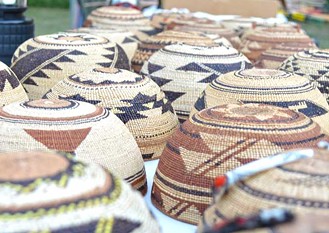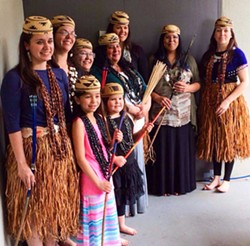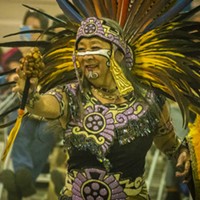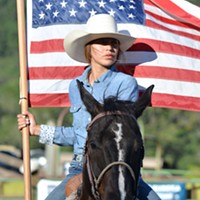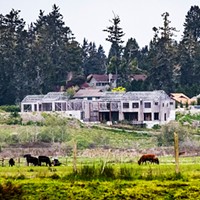[
{
"name": "Top Stories Video Pair",
"insertPoint": "15",
"component": "17087298",
"parentWrapperClass": "fdn-ads-inline-content-block",
"requiredCountToDisplay": "1"
}
]
The Hupa women’s coming-of-age ceremony (Ch’iwa:l) lasts for three, five, or 10 days and is held after a girl starts menstruating. The ceremony is a public celebration that includes specific practices and ritual guidelines for the young girl. This ceremony is particularly important to the Hupa people, as it was thought that the girl’s behavior during these days “would influence her destiny throughout life.” At one time the Flower Dance was a principal dance of our tribe but, after the destruction and genocide of the Gold Rush era, the influence of the boarding school, policies enforced by the Bureau of Indian Affairs, the missionaries and other lasting traumas of colonization, the Flower Dance was very rarely practiced, no longer the public celebration it had once been. Throughout the invasion of California, Native American women were targets of devaluation and conquest, exploitation and exclusion. At a point it became dangerous for Hupa people to do this dance. There were old stories about miners specifically targeting young women in this dance by coming to the dance and taking the young woman to rape her. They said it was justified. They said that we were letting everyone know she was a woman now, which meant we were letting everyone know that she was ready to have sex, willingly or unwillingly. Boarding schools and other government programs and agents specifically tried to teach us that this dance was bad, that it was part of our “primitive” ways. This dance was tied to savagery and oppression of women. We were told that our celebration of menstruation just proved that we were dirty, stupid, primitive people. Why would you celebrate menstruation? Why would you ever celebrate young women like that?
While the Ch’iwa:l was infrequently practiced for a number of years following invasion and then occupation by settlers, this does not mean the dance did not continue as an active part of the Hupa cultural imagination. Though there had been consistent pressures and dangers associated with the continuing practice of this ceremony, Hupa elders pushed for a revitalization and refused to forget that this ceremony is a central part of Hupa culture. Some individual dances were performed in 1975 and 1980, but these were not the public ceremonies they had once been. Hupa elders like Alice Pratt, Herman Sherman Sr., Ray Baldy, Rudolph Socktish, SuWorhrom David Risling Sr., and many others would continue to document, record and tell stories about the Ch’iwa:l well into the start of the new millennium.
For many years my mother, Lois Risling, along with several other women from my tribe, would work to revitalize the women’s coming-of-age ceremony in Hoopa. They would pore over anthropological records and sit with elders to remember stories and songs that had been passed on for generations. After the first revitalized ceremony was held in May of 2001, for a young woman named Kayla Rae Carpenter (now Begay), my mother called me on the phone and told me about the ice on the water, the long night of singing and that moment when Kayla emerged after her ceremony was over. “She was glowing,” she told me. “You can even see it in the pictures. She was bathed in light.”
The following excerpt comes from my book We Are Dancing For You: Native Feminisms and the Revitalization of Women’s Coming-of-Age Ceremonies recently published by the University of Washington Press. The excerpt highlights the kinahłdung (Flower Dance girls) and includes interviews with Melodie George-Moore, Lois Risling, Kayla Rae Begay, Natalie Carpenter, Alanna Lee Nulph, Melitta Jackson, Deja George and Naishian Richards.
The First Kinahłdung
Kayla is my younger cousin and, even though we grew up on the periphery of each other’s lives, I had mostly gotten to know her in the years when her family organized and led our world renewal ceremonies — the Deerskin Dance and the Jump Dance. Her grandfather Mervyn George Sr. is the dance leader and owner of the xontah-nikya:w, the sacred house at Ta’k’imi-ding village, where our shared family ancestor Mary Baldy Socktish carried on the ceremonies during the early 20th century, and where the Hupa people continue to practice many of these ceremonies to this day. Over the past few years I have gotten to know Kayla much better as I watched her grow, graduate from high school, attend Stanford University and, finally, University of California at Berkeley for graduate school in linguistics. She is now an assistant professor of Native American Studies at Humboldt State University. I truly admire her for the passion she displays when talking about the Hupa language. Throughout our interview she interspersed her responses with Hupa words, something that seems to come naturally to her now, and I noticed on several occasions she seemed to prefer the Hupa word to English, as she said several times, “How you say it in English is kind of like this,” because it is sometimes hard to explain Hupa using English.
Calling her the “first kinahłdung” is a bit of a misnomer. Our first kinahłdung is still very much part of each Hupa person’s world, as she has a Ch’iwa:l performed for her, for all time, in the K’ixinay afterworld. When the dance is called down by the Hupa people, the K’ixinay stop their dance and (some say) point their sticks at the dance place where the Hupa people are. Others say the K’ixinay attend our dance as we celebrate these girls who are becoming women.
Running is a signifigant part of the three- to 10-day ritual activities, as it is believed that how the young woman runs demonstrates how she will live her life. During the day she is attended by visiting women who offer advice; she is taught songs, prayers and skills by older women. She ceremonially bathes in the river and steams with herbs each day. As she picks herbs for her steam bath, she must grind them in a deliberate way. This kind of meaning and metaphorical representation can be found throughout the ceremonial practices, and the Hupa value their community and public aspects. There is no shame in the celebration of a first menstruation and bringing the community together illustrates to the girl (and the community) how important these young women are to the tribe and culture.
Kayla would have her Ch’iwa:l when she was 14, in May of 2001. This would be the first public community Ch’iwa:l in the Hoopa Valley for a number of generations. Kayla’s mother, Hupa medicine woman Melodie George-Moore, describes Kayla at this time as having “the presence of mind to learn a lot of these things, not just have them done to her. She was an older girl and she was not a complainer. You have to have sort of a mental toughness already to begin this and she was a good pupil. She had an open mind.”
Kayla explains, “My mom asked me if I wanted to do it and I thought that if I could do it, it could happen for a lot more other girls who would, who could use it and need it, and that was my thought. And I thought, if I could do it, if I could be strong and I could do it, then other people who need this dance could have it too, and that was sort of an easy decision to me. And that’s what happened.”
Kayla’s dance, being that it was the first public dance performed in such a long time, was surrounded by an air of what Lois Risling describes as “anticipation and excitement ... not only for the young woman but everybody else involved. It was just as important for the mother, just as important for the grandmother, just as important for the women who were coming to sing, to be there and participate in it, as it was for the young woman.”
Both Kayla and her mother reflected on how important this dance was to the entire family as well. While the dance was meant to honor and solidify Kayla’s coming-of-age, by the sheer force of having to plan and come together for a dance, Kayla’s family participated in healing from some of its own fissures. “I think that on a personal level, because my parents were getting a divorce, it meant that we were all still working together as a family for myself and for my other siblings, for the children,” Kayla says. “So in a big way it’s family medicine. You’re focusing on the girl, but in many ways there’s a lot going on in her circle that is her family, and that is family medicine.”
Kayla’s dance would set the tone for many of the conversations and experiences that followed. All of the kinahłdung interviewed reflected on how watching Kayla run made them excited about running, watching her sing made them excited about singing, seeing her smile after she had finished her dance made them want to know what that feeling was like. Melodie reflects that this dance needed to be first and foremost about Kayla and her ties to her culture and people in a very contemporary context:
In my mind historical trauma is the continuation of unhealthy patterns of behavior. Unknowingly, we give these to our children, and I had wanted that to not happen. ... What I had hoped I was doing was balancing her spirit, putting on what I characterized as a suit of armor so that in going out into the world, because I knew she was going to go to college and go out into* the world ... to know who she is as a Hupa person, [so] that nobody would be able to disrupt anything. And that’s held true, she’s held her ground in a number of different places, in a number of different countries, in a number of different languages — that has held true. She knows who she is and can call on that strength at any given time; call on the strength that is Hupa, the land, the people, the language [and] the ancestors.
Kayla is now the oldest of the kinahłdung who have participated in this revitalization. She demonstrates quite clearly that her mother’s hope that this ceremony would give Kayla a sense of who she is as a Hupa person so that she can “call on that strength at any given time” has been fulfilled. Toward the end of her interview, Kayla pauses for a moment to take a sip of water before she tells me, “In my spiritual life there’s a lot that I can reference to that time. It’s not that I’m working from base zero, just learning about my culture. My family really gave me a lot. They taught me a lot during that time. Not that they don’t teach me otherwise, but that actual experience, living that experience in my body, has given me knowledge on how to be a Hupa woman.”
There is a photo of Kayla standing next to her grandmother after her dance that my mother gave me when I started this project. In it, Kayla wears a hooded sweatshirt (a very clear marker of her modern Native life) along with her bark skirt and her blue jay veil. Surrounding her, all around her, from head to toe, is a bright white light that emanates from her body. There is no mistaking the power and energy that has been captured in this photo: In this moment her smile is wide and her stance tall and powerful. This will be the image that I, and so many others, will carry with us as we watch her grow into a powerful Hupa woman, our first kinahłdung.
The Hupa Women’s Flower Dance: Decolonization in Action
Continuing research shows that Native American cultural practices and community support are positive indicators that can address issues of self-esteem, poverty, school performance and resilient adaptation in adverse situations. Theresa LaFromboise and her coauthors found that a supportive relationship with one’s mother, an involvement with cultural practices and a supportive social community can support resilient adaptation by youth. Both Alanna Nulph and Melitta Jackson commented that the community involvement in the dance was an important part of how they expanded their circles of support.
I think the dance brings a lot of people together. That kind of dance especially, because — I mean, even if ... even if Mom is not in the picture or if Dad’s not in the picture, you know that side of the family needs to come together for this girl, and the family comes together for her. ... Who cares about if they are fighting or who cares about what somebody said about somebody two years ago or who borrowed 20 bucks and never brought it back or you steal fish out of my net or whatever. It’s — who cares about that — this kid, this child, this girl needs us right now.
A lot of [this dance] is representation of the support you have in the community. I really appreciated the talking circles ... it was just constantly seeing these women every day. It’s like, they could leave at any moment but they’re not. This is what they are here for and I appreciated it. ... It helped signify how I stood in the community.
Now that this dance has been reclaimed for over a decade in the Hoopa Valley, it has once again become part of the living, vibrant cultural practices of the Hupa people. Since the revitalization of the Ch’iwa:l, there have been at least one to four dances per year. Girls are now requesting and planning their Flower Dance from a very young age. My daughter Arya, who is 10 years old, does not know a time when we did not do this ceremony; she does not know a time when women and men did not come together to celebrate a girl and her first menstruation. As she grows, my daughter constantly plans her dance. For her, this is who we are as Hupa people: We celebrate young women and we believe in their ability to contribute immeasurably to our society.
Hayah-no:nt’ik’
It Reaches So Far, The Story Extends to There
Toward the end of my interview with Hupa Medicine Woman Melodie George-Moore, she shared a story with me about a song that came to her just as she was readying herself to attend a newly revitalized women’s coming-of-age ceremony with the Wiyot people in Eureka, the first they had held in 150 years. The history of the Wiyot, who were the aboriginal people in both Eureka and Arcata, now the two largest city centers in Humboldt County, was filled with horrific tales of massacres, enslavement and imprisonment. The Indian Island Massacre of 1860 remained a palpable reminder of Humboldt County’s genocidal history but also, importantly, a small fraction of Wiyot history — which includes a long history that ties the people to the land well before and after the Indian Island Massacre. In 2014 the Wiyot were preparing to do their women’s coming-of-age ceremony for a young woman named Michelle Hernandez. This would be the first of a few ceremonial revitalizations for the Wiyot, which would include the renewal of their Jump Dance ceremonies performed on Tuluwat (Indian Island) itself.
Melodie George-Moore’s dream came to her just before she was supposed to go to Michelle’s ceremony. In her dream she embodied a Wiyot woman in the 1800s. She and a number of other women found themselves at a fair (or something like it), where they quickly realized they were in danger from a mob of people who were getting drunk and rowdy around them. A musician playing there agreed to help the women escape the crowd of people. One of the women had a young girl with her. They ran for the woods but realized that the mob was going to catch them. They told this musician, a white man, to care for the little girl. And they told him that they were going to sing a song, and they wanted him to remember it, so that he could teach the little girl the song of her ancestors. The women sat together in a circle and sang. And they told the man to not forget it. Melodie said, “I remember thinking, ‘He’s going to remember that song, too. We’re going to have to be OK with him singing the song on the guitar. It’ll be changed, but it’ll be our song. He’ll teach it to her.’” That song came to her across time and space. These songs, she said, finding their way back to us, have just been waiting for us to reach out and hold on to them again.
Across the globe, Indigenous peoples are reclaiming their cultures, histories and epistemologies through language, ceremony, song, governance and story. In the local Northern California region, ceremonial revitalizations have included the Coastal Yurok, who performed their first reclaimed women’s ceremony in Trinidad at Sumeg Village in the early 2000s for a young woman named Kayla Maulson, a member of the Trinidad Rancheria. Women’s coming-of-age ceremonies continue at Sumeg Village to this day with the guidance of Kishan Lara-Cooper and Walt Lara. The Karuk, also neighbors of the Hupa, worked to revitalize a women’s ceremony known as the Ihuk beginning in 1996. Lyn Risling was instrumental in this revitalization and continues to be involved in these ceremonies for young women.
Hupa, Yurok, Karuk, Wiyot, and many other Indigenous peoples — we are world renewal dancers. We are able to demonstrate through song, through prayer, through laughter and stories and dance that we believe in our future, that we continue to see our future as tangible. Every song, every story is a living moment that we can access again many years later. We are not sad, dying Indians and this documentation of our revitalizations is not of a dying culture, but instead of a culture that has always envisioned an Indigenous future. In Hupa when we end a story we say hayah-no:nt’ik’, which means “that’s the end of it” or “the story extends to there.” But it has an additional meaning, “it reaches so far,” as if to remind us how our stories stretch into our future and that we are always reaching forward.
Hayah-no:nt’ik’.
There will be a reading and signing of We Are Dancing For You on Aug. 5 at Humboldt State University’s Native American Forum (BSS 2017) from 4 to 5 p.m.
Dr. Cutcha Risling Baldy is an assistant professor of Native American studies at Humboldt State University. She is Hupa, Karuk and Yurok, and enrolled in the Hoopa Valley Tribe.
Speaking of...
more from the author
-
My Cousin Emmi
MMIW isn't statistics. It's my family.
- May 5, 2022
-
Every Number is a Person
Humboldt's missing and murdered Indigenous women, girls and Two Spirit people
- Aug 13, 2020
-
Representation Matters
Native people are doing awesome things but, please, let's talk about Johnny Depp
- Oct 3, 2019
- More »
Latest in News
Readers also liked…
-
Through Mark Larson's Lens
A local photographer's favorite images of 2022 in Humboldt
- Jan 5, 2023
-
'To Celebrate Our Sovereignty'
Yurok Tribe to host gathering honoring 'ultimate river warrior' on the anniversary of the U.S. Supreme Court ruling that changed everything
- Jun 8, 2023
